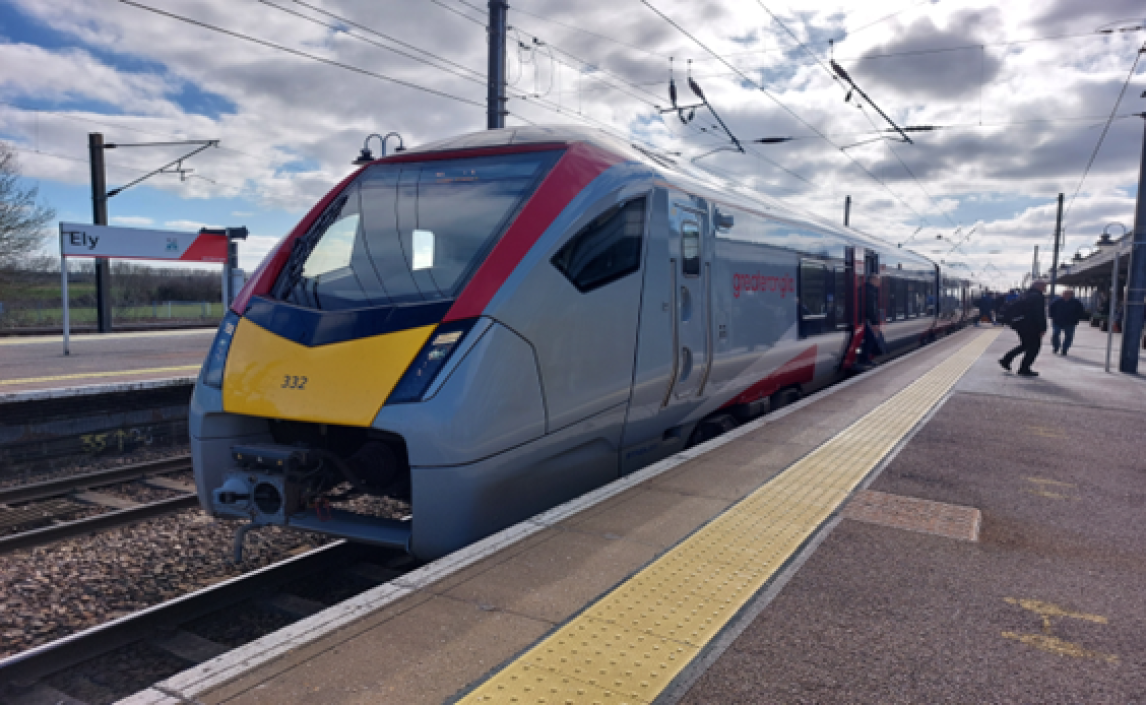Published on: Wednesday, 13 December 2023
Last updated: Wednesday, 13 December 2023
A Greater Anglia bi-mode train at Ely. Credit: Greater Anglia.
The bi-mode trains used by Greater Anglia on its regional routes are set to save thousands of litres of diesel a year, now that they are able to change power supply on the move.
The 38 trains, built by Stadler, which first started entering service in July 2019, run primarily on the company’s routes between Norwich and Great Yarmouth, Lowestoft, Sheringham and Cambridge/Stansted Airport, and between Ipswich and Cambridge, Felixstowe, Lowestoft and Peterborough, along with the Marks Tey - Sudbury branch, most of which are non-electrified.
However, the Ely North Junction to Cambridge/Stansted Airport section of the Norwich to Cambridge route and the Ipswich to Haughley Junction section of the Ipswich to Cambridge/Peterborough route are electrified and the whole of the Great Eastern Main Line, by which bi-mode trains may be travelling to/from some of the non-electrified routes, is also electrified. That means there are significant opportunities to take greater advantage of electric power, especially if you can do so at the first point you reach it, rather than only from the nearest station to the “changeover point”.
The bi-mode trains, known as ‘class 755s’ can run using either diesel or electricity from the overhead wires – but previously were restricted to changing over their power supply in station platforms.
Thanks to special zones that have recently been put in place on the network, drivers can press a button to allow the power supply to change between diesel and electric while on the move. This will save at least 91,000 litres of diesel a year, as well as stopping more than 240,000 kilograms of co2 being emitted – enough to power more than 30 homes for a year.
The power supply can now be changed on the move at four locations:
- Ely North Junction, on the line between Norwich and Cambridge
- Haughley Junction near Stowmarket, on the route between Ipswich and Cambridge/Peterborough
- Lakenham near Norwich heading towards Ipswich
- Marks Tey coming on and off the branch line for Sudbury for trains coming to/from the stabling and maintenance point at Colchester
Benjamin Parry, Greater Anglia’s Interim Engineering Director, said:
“The new way of working, known as ‘dynamic power changeover’, means that our drivers can change to electric power on the move as soon as it is available, rather than waiting to do so at a station.
“We predict the change should save more than 91,000 of litres of diesel per year and, saving over 240,000 kilograms in co2 emissions, be even greener too.
“Our trains have been gamechangers for our customers over the past four years since they started service and we hope that they will begin to have such a significant positive impact on the environment across Essex, Suffolk and Norfolk too.”
The Stadler-built trains are more environmentally friendly than the ones they replaced, which ran entirely on diesel, in a number of other ways.
They also come with regenerative braking, which delivers energy back into the electrical supply network, rather than wasting the energy through heat as is the case with conventional systems.
Greater Anglia’s final phase of its new trains project is now underway, with 113 of its 133 new commuter trains, built by Alstom, accepted for passenger service on its network.
These fully electric ‘class 720’ trains run on commuter routes to and from London Liverpool Street as well as on selected branches serving destinations such as Bishop’s Stortford, Cambridge, Clacton, Harwich Town, Ipswich, Southend Victoria and Southminster.



